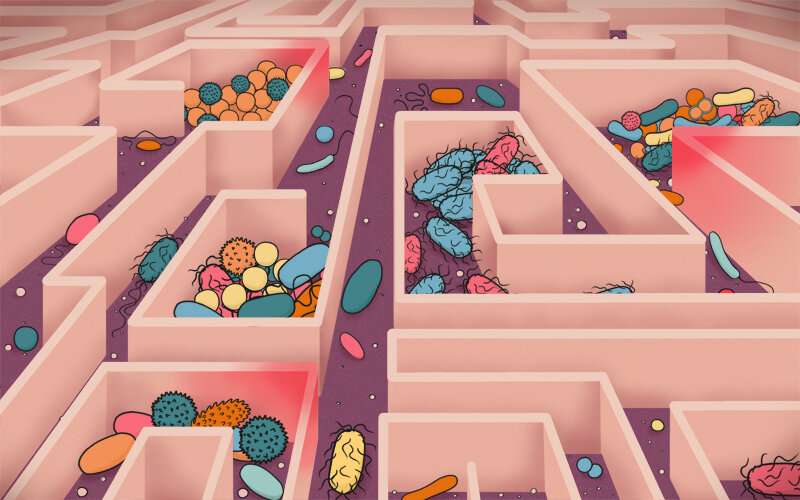Aging and nutrients competition determine changes in microbiota

Research groups from Instituto Gulbenkian de Ciência (IGC) that study evolution, immunity and microbiology unveiled two new mechanisms in the microbiota: in older populations, the bacterium E. coli evolves in a way that can become potentially pathogenic and increase the risk of disease and, according to data obtained in another study, the metabolism of the same bacterium present in the microbiota differs if it is alone or accompanied by other bacteria. The discoveries are available in the latest edition of Current Biology.
Driven by the discovery of mechanisms associated with the microbiota (the set of microbes that make up the intestinal flora) and its impact on health, the two scientific articles now published are the result of work previously developed at IGC and which involves three Research Groups. In 2014, when researchers first realized that the bacterium E. coli, when introduced into the host, developed genetic mutations with a speed and frequency never before anticipated, new questions arose: What is the influence of the other species of bacteria in the intestine in this process? What influence does host aging have on the process? What impact does inflammation have on the evolution of the microbiota? What genetic mutations occur and how do they happen?
Using the mouse as an animal model (host) and the bacterium E. coli, a well-studied colonizer of the human intestine that is susceptible to mutations in the intestinal tract, the research groups have unveiled two new mechanisms in the microbiota. The research group led by Isabel Gordo is interested in understanding how bacteria evolve. Knowing that old age leads to changes in the composition of gut bacteria, the study now published looked at populations of young and old mice and how E. coli evolved in both communities.
Assuming that old age is associated with a progressive deterioration of the host functions, the surprising fact that resulted from this work shows that E. coli evolves in the elderly to cope with the stressful environment, becoming potentially pathogenic and potentially increasing the risk of disease. The inflammation associated with the old age of the host gives an added stress factor to the bacterium in the gut, causing it to evolve into a version potentially more dangerous to the health of the host.
For Isabel Gordo, leader of the research group, "it was fascinating to observe that in just one month of colonization of the old mice, the evolution of E. coli revealed its versatility in acquiring mutations capable of adapting to the pressure imposed by the increased inflammation of the intestine."
The discoveries now made will allow the start of a new investigation focused on the study of these mechanisms in people with inflammatory bowel disease. In Portugal alone, inflammatory bowel disease (such as Ulcerative Colitis and Crohn's Disease) affects about 7000 to 15000 people and impacts their quality of life.
Knowing that E. coli evolves in young and elderly people differently, since in the intestine of the elderly the type of colonizing species differs from the type that colonizes the youngest, the researchers wanted to understand how this bacterium acts when alone or when accompanied.
The research group led by Karina Xavier, responsible for studying the signaling features of bacteria, found that the metabolism of E. coli differs if it is alone or in the company of other bacteria.
When introduced into the host alone, E. coli proved to be an excellent colonizer, gaining a lot of space in its environment and consuming amino acids. When it is introduced in the company of another bacteria from the microbiota, Blautia coccoides, the investigation revealed that the genetic changes of the bacterium happened faster and in a mora diversified way due to the interaction: there is competition for available nutrients and E. coli starts to consume other nutrients, only made available due to the presence of B. coccoides.
This work shows that the evolution of E. coli in the mouse gut is responding primarly to the interaction with other members of the microbiota. According to the leader of the research group, Karina Xavier, "our data demonstrates that the presence of a competing species in the host's intestine alters the metabolic environment of the gut, and the bacteria quickly adapt to the new metabolic environment by reshapping their metabolism."
When alone in the gut E. coli evolved to be more efficient in consuming amino acids, as these were the most abundant nutrients in the intestines. In the presence of a member of the microbiota amino acids become scarce and simple sugars released by the metabolism of the micobiota members become available and thus evolution favored selection for mutants that are better in consuming these compounds. In the future "we will study how the microbiota reacts and evolves in the presence of different host behaviors, such as the type of diet, and how this is reflected in health or pathogenicity."
More information: Hugo C. Barreto et al, The Landscape of Adaptive Evolution of a Gut Commensal Bacteria in Aging Mice, Current Biology (2020). DOI: 10.1016/j.cub.2020.01.037
João Barroso-Batista et al. Specific Eco-evolutionary Contexts in the Mouse Gut Reveal Escherichia coli Metabolic Versatility, Current Biology (2020). DOI: 10.1016/j.cub.2020.01.050
Journal information: Current Biology
Provided by Instituto Gulbenkian de Ciencia





















